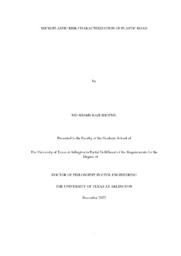| dc.description.abstract | In recent past, the act of waste recycling has been diversified in manifolds across
the world leading to evolution of newer recycling technique and fresh recycled
product. Albeit plastic is one of those waste materials which is getting extremely
difficult to get substantially recycled because of its record-breaking production,
consumption, and its wide range of variations in properties ultimately leading to
substandard recycling status of plastics globally. This seemingly poor status of waste
plastics recycling against the gargantuan amount of fresh plastic products being added
to consumer stream gives rise to a menacing one directional problem: Plastic Pollution,
which is getting worse day by day. Having said that, designing a viable way for
repurposing large scale plastic wastes instead of traditional recycling could divert that
one directional problem to a more prosperous circular economy. One such way to
repurpose large scale waste plastics is construction of an integrated plastic road
incorporating shredded waste plastics in multiple layers of a flexible pavement.
Concept of integrated plastic road would not only ensure macroscale use of plastic
waste but also refrain the plastics being accumulated in the landfills eventually
minimizing the worldwide waste plastics crisis.
For this study, different types of plastics (HDPE, LDPE, PP, PET) have been
incorporated with other recyclable components like Recycled Crushed Concrete
Aggregate (RCCA) and regular pavement material like bitumen for base and surface
course of a flexible pavement. However, introduction of plastics as a roadway material
gives rise to the potential environmental hazard, and most importantly microplastic
risk which itself is an emerging global concern. This study aims at identifying,
quantifying, and characterizing microplastic risk associated with a plastic road from
an ecotoxicological point of view. Moreover, a number of common environmental
leaching tests (COD, TDS, TSS, Specific Conductance) have also been carried out and
compared against the USEPA urban stormwater runoff benchmarks. Microplastic risk
has been assessed with respect to the toxicity parameter called Predicted No Observed
Effect Concentration (PNEC). PNEC is the maximum allowable microplastic
concentration that could be tolerated by microorganisms without having any adverse
physiological impacts. Microplastic concentration has been quantified using an optical
microscope and qualified by using Fourier Transform Infra-Red (FTIR) spectroscopy
to corroborate the presence of microplastic in experimented sample. Measured
concentration was then divided by PNEC to get the Risk Characterization Ratio
(RCR). If RCR value is less than 1, the corresponding microplastic concentration does
not pose any threat to the ecological system. RCR values have been measured for two
different weathering cases of base course and surface course of a plastic road.
For case I, where base course cylindrical representative specimens are kept
submerged in contained water for 28 days to collect the leaching sample, average RCR
has been observed as 0.103 which is significantly lower than 1. In case I, samples
incorporating PP plastic type exhibit relatively more RCR values ranging from 0.063
to 0.253. Case II also represent base course yet a different weathering condition where
the cylindrical specimens were subject to cyclic loading before 28 days water
submergence. This case resembles the long term microplastic risk characteristics. For
this case, average RCR obtained is 0.735 which is higher that of case I, yet lower than
the RCR threshold 1. In this case, however one incidence attributes to a RCR more
than 1 involving PP type of plastic. The final case is representative of surface course
incorporating shredded plastics. Leaching samples for this case are collected from
submerged cylindrical specimen exerted by repetitive wheel passing in a Hamburg
rutting test setup. For this case, average RCR observed is 0.186 which is the lowest of
all three cases. Regardless of the case, weathering condition, plastic type, constituent
percentage, this study shows that RCR value remains less than 1 implying that plastic
road does not pose any ecological threat in terms of microplastic toxicity. And finally,
this study also envisages Multiple linear Regression (MLR) models for both base and
surface course to predict the RCR value based on primary constituent parameters and
resulting predictor variables. | en_US |


